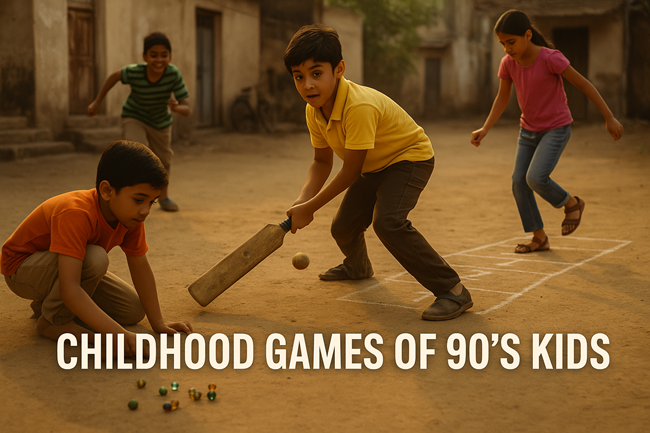Growing up in the 90s in India was truly special. We were the last generation to live a childhood untouched by smartphones, social media, and gaming consoles. Our lives were filled with simplicity, outdoor adventures, scraped knees, and belly-aching laughter that echoed in the narrow lanes and open fields. If you’re a 90s kid, you know what I mean — stepping out barefoot in the summer, gathering with friends after school, and playing until the sun set and moms called us back home with loud, familiar voices.
The outdoor games we played were more than just pastimes — they were life lessons, bonding experiences, and our own version of fitness routines. Sadly, many of these games have lost their place in today’s gadget-driven world. Let’s relive those golden days by revisiting the outdoor childhood games that 90’s kids in India grew up with — games that defined an era and shaped our growing years.

90s Kids Outdoor Games in India Are :
1. Gully Cricket
Number of players: 4 to 12 (or more depending on space)
What you need: A bat, a ball (often a tennis ball), and some makeshift wickets (bricks, bags, or even shoes)
No childhood in India, especially in the 90s, was complete without Gully Cricket. Whether it was played in narrow streets, school grounds, or empty plots, this game brought the whole neighborhood together. Rules were flexible, boundaries were defined by parked scooters, and arguments about “out” or “not out” often turned into intense debates.
The best part? Even if someone didn’t have a bat, we’d find a wooden plank, or someone would bring their elder brother’s bat. It wasn’t just a game — it was a way of life.
2. Kho-Kho
Number of players: 12 players (6 from each team on the field)
What you need: An open ground and lots of stamina!
Kho-Kho was one of the most thrilling tag games, requiring strategy, speed, and teamwork. It involved one team chasing the other by tagging members while running around a central line. Players from the chasing team sat alternately facing opposite directions and passed the chase by tapping teammates on the back and saying “Kho.”
What made Kho-Kho fun was its fast-paced energy and clever tactics to dodge and tag. School sports days were incomplete without this traditional Indian game.
3. Pittu (Seven Stones / Lagori)
Number of players: 6–10
What you need: A soft ball and 7 flat stones
Pittu, also known as Seven Stones or Lagori in different parts of India, was a classic. The game began by stacking seven stones on top of each other. One team would knock down the stones with a ball and try to rebuild them, while the other team tried to hit them with the ball to stop them.
The laughter, shouting, and the desperate attempts to dodge the ball — that’s what childhood joy looked like. It was a perfect mix of aggression, strategy, and team spirit.
4. Langdi Taang
Number of players: 4–10
What you need: Open space
This game tested both balance and stamina. In Langdi Taang, the chaser had to hop on one leg and tag the runners. Sounds easy? Try hopping on one leg for 5 minutes while chasing someone at full speed — it was exhausting and hilarious at the same time!
Mostly played in schools during break time, Langdi Taang was simple yet extremely entertaining.
5. Pakdam Pakdai (Tag)
Number of players: Unlimited
What you need: Just your running shoes!
Also known as catch-catch, Pakdam Pakdai was the go-to game when you had nothing else. One person was “it,” and the rest had to avoid getting caught. It didn’t need any equipment, just pure energy and open space.
Variations like Chain Pakda Pakdi (where caught players joined hands to form a chain) and Ice & Water (freezing players until someone “melts” them) made it even more fun.
6. Hide and Seek (Lukka Chuppi)
Number of players: 4 to 10
What you need: A neighborhood with plenty of hiding spots
Hide and Seek was the universal favorite. Someone would close their eyes and count loudly while others ran to find the best hiding spots. From behind water tanks to under staircases, the adrenaline rush when someone was almost caught was unmatched.
And if you were “it,” you’d anxiously try to spot people while pretending to be calm. Lukka Chuppi brought suspense, thrill, and sheer excitement to our evenings.
7. Maram Pitti
Number of players: 4–8
What you need: A soft rubber ball
This was India’s version of dodgeball, played with a single ball and no teams. The person with the ball tried to hit others while they dodged. If you got hit, you were out.
The best moment? Dodging a fastball like a pro and watching it hit the wall instead. The game usually ended when the ball went missing or someone got hurt — whichever came first!
8. Stapoo (Hopscotch)
Number of players: Solo or 2–4
What you need: Chalk and a small flat stone
Mostly played by girls but enjoyed by all, Stapoo or hopscotch involved drawing numbered boxes on the ground and hopping through them on one leg, retrieving the stone without stepping out.
It required balance, coordination, and sometimes a little bit of cheating when no one was watching. The colorful chalk drawings often stayed on the ground for days.
9. Gilli Danda
Number of players: 2–6
What you need: A small stick (gilli) and a longer stick (danda)
This traditional Indian sport was like a rural version of baseball. The player used the danda to flick the gilli into the air and hit it as far as possible. The rest of the game involved running and scoring, but honestly, most of us just loved whacking the gilli as hard as we could!
10. Kancha (Marbles)
Number of players: 2–5
What you need: Colorful glass marbles (kanchas)
Boys especially were obsessed with collecting and winning kanchas. The goal was to hit another person’s marble by shooting yours with a flick. Precision and aim mattered, and bragging rights came with every win.
Some even had their prized “King Kancha” — slightly bigger and shinier — that everyone envied.
11. Dog and the Bone
Number of players: 10 or more
What you need: A handkerchief or small stick
Two teams would stand in lines facing each other. One player from each side would run to grab the “bone” kept in the center and rush back to their side before being tagged by the opponent.
The tension, the fake moves, the sudden sprints — this game had drama, speed, and a whole lot of fun!
90s Kids Outdoor Games : Why These Games Mattered
These games were not just a source of entertainment. They taught us teamwork, leadership, resilience, and creativity. We learned how to resolve fights, take turns, accept defeat, and celebrate wins — all without a scoreboard or umpire.
They helped us stay active, social, and emotionally connected to our friends and surroundings. Unlike today’s screen games, these involved real sweat, laughter, and sometimes even real tears.
90s Kids Outdoor Games : The Sad Reality Today
With smartphones, OTT platforms, and indoor entertainment ruling children’s lives, these games are almost extinct. Playgrounds are shrinking, parks are turning into parking lots, and free playtime is being replaced by structured activities or mobile games.
It’s up to us — the 90’s kids turned parents and educators — to revive these games, to ensure the next generation doesn’t miss out on the magic we grew up with.
90s Kids Outdoor Games: Final Thoughts
Being a 90’s kid in India meant growing up with scraped knees, dusty faces, and hearts full of joy. Our childhood was enriched by outdoor games that were free, fun, and full of life lessons. While times have changed, the memories haven’t.
Let’s pass on the legacy of these games to our children take them to open fields, teach them how to play, and let them experience what real joy felt like before screens stole it.
So, what was your favorite 90s outdoor game? Share it with us in the comments! Let’s keep the nostalgia alive.
90s Kids Outdoor Games : Frequently Asked Questions (FAQs)
Q1. What were the most popular 90s Kids Outdoor Games in India?
A: Some of the most popular outdoor games that 90s kids in India loved playing include:
- Gully Cricket
- Kho-Kho
- Pittu (Seven Stones / Lagori)
- Pakdam Pakdai (Tag)
- Hide and Seek (Lukka Chuppi)
- Langdi Taang
- Gilli Danda
- Stapoo (Hopscotch)
- Kancha (Marbles)
- Dog and the Bone
These games were simple, required minimal or no equipment, and brought entire neighborhoods together.
Q2. Why are these traditional outdoor games no longer played widely today?
A: The decline of these outdoor games can be attributed to:
- Increased screen time due to smartphones, tablets, and video games
- Limited open spaces and playgrounds in urban areas
- Academic pressure and busy schedules of children
- Shift in lifestyle and parenting patterns
Despite this, there’s a growing movement among educators and parents to revive these games for their physical, emotional, and social benefits.
Q3. How did these 90s Kids Outdoor Games benefit children?
A: These games were much more than just fun. They:
- Encouraged physical activity and fitness
- Taught teamwork, strategic thinking, and problem-solving
- Built resilience, sportsmanship, and communication skills
- Fostered creativity and resourcefulness
- Strengthened community bonding and neighborhood friendships
They played a crucial role in holistic childhood development.
Q4. Can these outdoor games still be introduced to children today?
A: Absolutely! These games can be reintroduced in schools, housing societies, birthday parties, and community events. Many educators use them during PT classes or fun breaks. Parents can also take the initiative by organizing weekend outdoor play with kids in parks or even apartment compounds.
Q5. Are there regional variations in these games across India?
A: Yes, several games had different names and slight variations across states:
- Pittu is known as Lagori in Karnataka and Maharashtra
- Kancha is called Golli in Tamil Nadu and Goti in Bihar
- Stapoo is also called Kith-Kith in North India and Tokkudu Billa in Andhra Pradesh
The core gameplay often remained similar, but the regional touch added unique flavor and cultural richness.
Q6. Which game required the most number of players?
A: Kho-Kho typically required the largest number of players, ideally 12 on the field (6 from each team) and more as substitutes. Dog and the Bone and Chain Pakdam Pakdai also worked best with larger groups and were usually played during school breaks or during community gatherings.
Q7. Were there any safety concerns with these outdoor games?
A: Most games were safe, but like any physical activity, they did involve minor risks like falling, bruises, or getting hit by a ball. However, these experiences helped kids develop situational awareness, tolerance to pain, and emotional maturity. Children also learned how to play carefully and look out for one another.
Q8. How can parents encourage children to play these games again?
A: Here are a few practical ways parents can revive these games:
- Dedicate weekend outdoor time for family play
- Organize group games during birthdays or picnics
- Coordinate with schools for traditional games days
- Share stories from your childhood to build curiosity
- Limit screen time and offer fun outdoor alternatives
Bringing back these games can be a great way to build healthier routines and stronger parent-child bonds.
Q9. What are the psychological benefits of traditional outdoor games?
A: Playing outdoor games improves:
- Emotional regulation: Dealing with wins, losses, and team dynamics
- Confidence: Through peer interaction and skill development
- Social skills: Learning cooperation, communication, and empathy
- Stress relief: Fresh air and physical play act as natural mood boosters
They’re essential for balanced mental growth and reduced dependency on digital distractions.
Q10. Can these games be adapted for small spaces or indoors?
A: Yes, several of these games can be tweaked:
- Stapoo can be played indoors using floor tiles or masking tape
- Kancha or Gilli Danda can be played with foam versions in hallways
- Pakdam Pakdai and Lukka Chuppi can be done in larger indoor areas or corridors
While the essence lies in outdoor fun, creative adaptations can bring similar joy even indoors.

Hi, I’m Prashant Jain — a curious soul, storyteller, and content creator at heart.I’ve always been drawn to the world of entertainment, travel, sports, health & lifestyle — not just as a writer, but as someone who genuinely lives these experiences. Whether I’m binge-watching the latest OTT series, exploring offbeat spiritual destinations in India, or diving deep into wellness routines and cricket match insights, I love sharing what I discover with like-minded readers.
PopNewsBlend is my way of blending personal journeys with meaningful stories — ones that inform, inspire, and keep you ahead of the curve. Everything I write comes from real observations, hands-on experiences, and a deep passion for understanding the world around us.
Discover more from Popnewsblend
Subscribe to get the latest posts sent to your email.








Pingback: 90s Kids Childhood Memories : Forgotten Childhood Moments